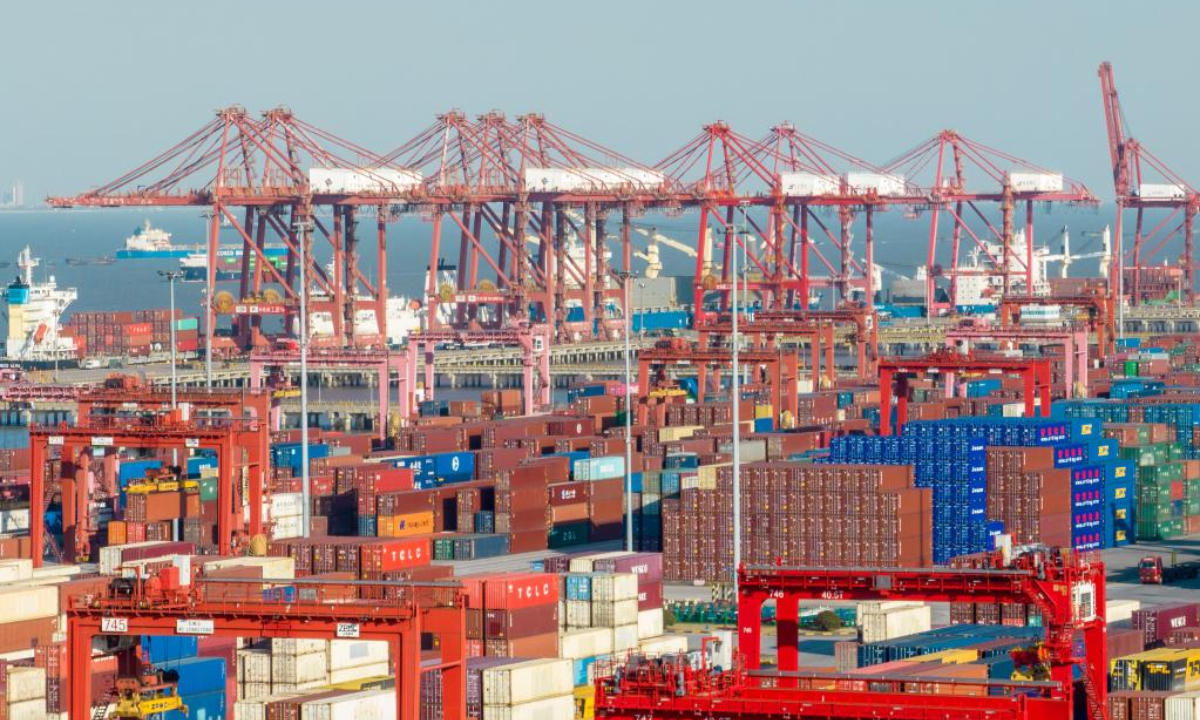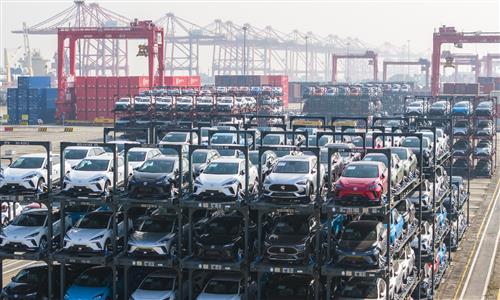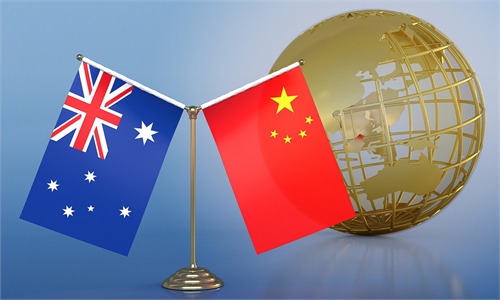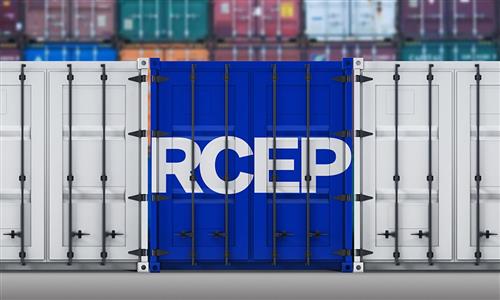
This aerial photo taken on March 13, 2023 shows a container terminal of Taicang Port, east China's Jiangsu Province. Photo:Xinhua
The Central Economic Work Conference at the end of 2023 proposed "accelerating the cultivation of new momentum in foreign trade." Notably, this is the first time the meeting has referenced the expansion of intermediate goods trade, emphasizing it as a priority item.
China is the most suitable country globally to become a strong and influential intermediary trade nation. Looking at the current international economic situation, it is crucial for China to tap into the potential of intermediate goods trade and expand its trade scale in order to become a global trading powerhouse. Fortunately, we possess the ability to achieve this goal.
Intermediate goods refer to products used in the production of other goods and services, such as raw materials and components used in the production process. They are the most crucial in international industrial chains and supply chains cooperation. For example, battery cells used in the production of lithium batteries and tin-coated copper strips used in the production of photovoltaic panels are both intermediate goods.
These immediate products are closely connected with the "new three items" contributing to China's exports - electric vehicles, lithium batteries, and solar cells, which in 2023 for the first time reached one trillion yuan ($140 billion) mark.
Intermediate goods trade is an often overlooked but crucial aspect in practical operations. Given the highly developed level of international division of labor, it is difficult for a product to be entirely produced in one country, often requiring multiple countries of circulation and manufacturing. The Central Economic Work Conference emphasized the need to expand intermediate goods trade because it recognizes that expanding this trade will be beneficial in expanding export potential, which is an important lever for a trade powerhouse in the current situation.
Public data shows that China has been the world's largest exporter of intermediate goods for 12 consecutive years, and intermediate goods contribute nearly 60 percent to the growth of foreign trade. Expanding the intermediate goods trade can not only fully leverage the advantages of China's mature industrial and supply chains but also unleash the advantages of the country's enormous market, advancing the realization of a new type of globalization through strengthened regional cooperation.
Regardless of whether it is Europe, the US, Japan, or South Korea, during the period of rapid trade development, intermediate goods trade accounts for a large proportion, reaching 40-50 percent in imports and 65-75 percent in exports. There is still room for improvement in intermediate goods trade.
With the continuous improvement of China's technological ecosystem and the promotion of industrial transformation and upgrading, some parts of final products can also be processed in Europe and the US, forming a global division of labor adjustment, thereby further expanding imports and exports and attracting foreign investment.
To become a major player in intermediate goods trade, China needs three conditions to be met.
Firstly, it needs a relatively complete industrial chain and supply chain, and it is moving from the mid-to-low end to the mid-to-high end in the global value chain. China has the advantage of a complete and comprehensive manufacturing industry with seamless connection between upstream and downstream sectors.
Secondly, it needs a strong international logistics infrastructure. Whether it is the China-Europe freight train or the Maritime Silk Road, China has enhanced cooperation with a number of countries for cross-border transportation, including air, sea, ports, and land transportation.
Thirdly, and most importantly, it needs a strong culture of research and innovation. China has the largest number of engineers and researchers in the world, thus fulfilling this third condition as well.
China can further leverage its advantage in having a complete range of industries and advanced modern technology in the manufacturing industry, and promote more intermediate goods to be processed.
Faced with increasing uncertainty over the future global economic landscape, a large number of Western manufacturing industries, technologies, and capital are shifting to the East, and the requirements for modern high-end manufacturing industries are becoming higher. Only countries with a complete range of industries and a highly integrated upstream and downstream manufacturing industry will be favored. China remains that preferred destination. This is especially true in industries experiencing new productive forces such as 5G, semiconductor electronic products, pharmaceuticals and biotechnology, medical devices, green technology, new-energy vehicles, robots. China's trade in intermediate goods in these fields has great potential.
Chinese enterprises, especially private firms, need to plan in advance how to attract the final processing, design, manufacturing, marketing, and service of global primary and intermediate products, making China the world's largest market for intermediate goods trade.
Through the Belt and Road Initiative and the strategy of enterprises "going global," China should extend the intermediate goods trade chain to foreign countries. China should help these countries establish primary manufacturing industries, process local raw materials and primary products, and enable these countries to integrate into the global industrial and supply chains, while promoting China to better utilize both domestic and foreign markets and resources.
A path needs to be forged to expand an intermediate goods trade with Chinese characteristics. Looking at the development of economic and trade processes in the US, Europe, Japan, and South Korea, they have also dreamed of becoming the "king of intermediate goods trade." However, why have these dreams not been brought to life? The key reason is that the profit-seeking nature of Western capital implementation leads to failure.
From this perspective, China's intermediate goods trade is inclusive, open, cooperative, and win-win, meaning that it is easily embraced by other countries. Therefore, it has strong vitality and development space. To a certain extent, it will also promote a new round of globalization.
Currently, there is a foundation and potential for China to expand its intermediate goods trade. China's intermediate goods trade has great development potential in the next five to ten years, which also indicates that China's foreign trade still has significant untapped potential. Expanding intermediate goods trade has become a critical path for China to become a strong trading nation.
The author is a former Chinese vice minister of commerce and executive deputy director of the China Center for International Economic Exchanges. bizopinion@globaltimes.com.cn



